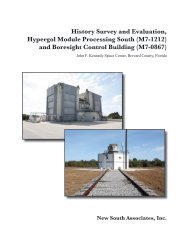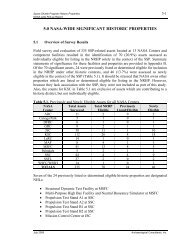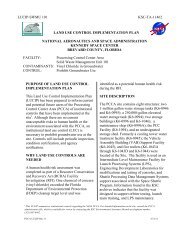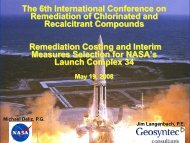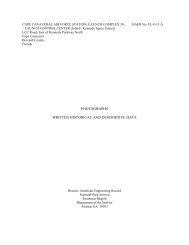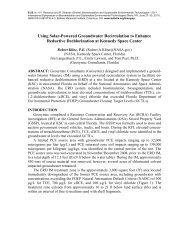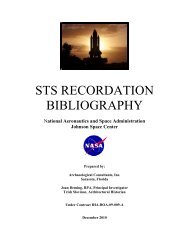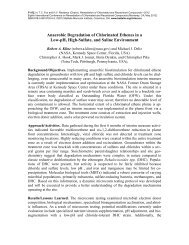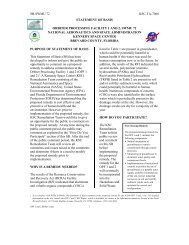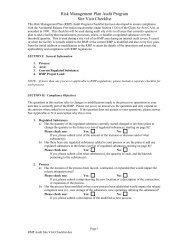john f. kennedy space center brevard county, florida - Environmental ...
john f. kennedy space center brevard county, florida - Environmental ...
john f. kennedy space center brevard county, florida - Environmental ...
Create successful ePaper yourself
Turn your PDF publications into a flip-book with our unique Google optimized e-Paper software.
• Azimuth Alignment Station (J7-537; 1967)<br />
• Camera Pad B #4 (J7-584; 1968)<br />
• Camera Pad B #3 (J7-589; 1968)<br />
Contributing Structures: Of the 14 contributing structures, 5 are camera pads and 5 are fuel<br />
facilities; the remaining 4 are the Launch Pad (also considered individually eligible), the Flare<br />
Stack, the Water Tower, and the Slidewire Termination Facility.<br />
Launch Pad 39B: LP 39B is comprised of four main features: the hardstand, the Flame Trench<br />
and Deflector system, the Fixed Service Structure (FSS), and the Rotating Service Structure<br />
(RSS), which includes the Payload Changeout Room (PCR). The surface of the LP 39A<br />
hardstand sits at 48 ft above sea level. Built within the hardstand are various subsurface areas,<br />
including catacombs, the High Pressure Gas storage area, an environmental control systems<br />
(ECS) area, a pad terminal control room (PTCR), and a blast room. On the surface of the<br />
hardstand are six mount mechanisms to support the Mobile Launcher Platform (MLP), and rail<br />
tracks for the solid rocket booster (SRB) side flame deflectors, as well as for the RSS. The Flame<br />
Trench sits just east of the <strong>center</strong> of the hardstand, extending north to south. The trench is<br />
constructed of concrete and refractory brick, and at the north end, where the flat surface of the<br />
hardstand terminates, the trench walls angle towards the west and east. The Deflector system<br />
contains two main elements: an inverted V-shaped steel structure that sits within the trench and<br />
directs the flames from both the solid rocket boosters (SRBs) and the Space Shuttle Main Engines<br />
(SSMEs), and the aforementioned pair of moveable deflectors that sit on the surface of the<br />
hardstand and help direct the flames from the SRBs.<br />
The FSS, formerly part of the Apollo-era Launch Umbilical Tower (LUT), measures<br />
approximately 40 ft in both length and width, and 347 ft in height, including the hammerhead<br />
crane and the lighting mast. The FSS has eleven platform levels that are accessed by either a set<br />
of metal stairs or one of two elevators. The first platform level is at 75 ft above sea level, and the<br />
remaining ten levels continue at 20-ft intervals. Access is provided to the MLP at the 95-ft level;<br />
access to the PCR main floor is at the 135-ft level. The 155-ft level has a platform to the orbiter<br />
midbody umbilical unit, and at the 195-ft level is the orbiter emergency egress arm, which leads<br />
to the orbiter crew compartment. The external tank (ET) gaseous hydrogen vent arm, which<br />
allows access to the ET’s intertank compartment, as well as aiding in the mating of ET umbilicals<br />
to the vent lines, sits at the 215-ft level. At the 275-ft level is the ET gaseous oxygen vent arm<br />
and “beanie cap,” used to heat the liquid oxygen (LOX) vent system at the top of the ET to<br />
prevent ice formation. Around 2 minutes, 30 seconds before launch, the “beanie cap” is raised,<br />
and 45 seconds later, the arm is retracted. At roughly 21 ft due south from the southeast corner of<br />
the FSS sits the hinge column for the RSS, which is supported by a triangular-footprint trussing<br />
system off of the south elevation of the FSS.<br />
The RSS contains the PCR, which has dimensions of 50 ft in length and width, and 130 ft in<br />
height, and contains five platform levels. The PCR functions as an airlock by maintaining the<br />
controlled environment required when payloads are inserted into or removed from the Orbiter.<br />
Within the PCR is the Payload Ground Handling Mechanism (PGHM), which is used to transfer<br />
the payload from the Payload Canister to the orbiter. Below the PCR, within the RSS, is an<br />
Auxiliary Power Subsystem (APS) access platform (at 107 ft) and an Auxiliary Power Unit<br />
(APU) access platform (at 120 ft). The RSS also contains the orbiter midbody umbilical unit,<br />
which allows access to the midfuselage area of the orbiter, and the hypergolic umbilical system,<br />
which carries fuel, oxidizer, helium, and nitrogen lines from the FSS to the orbiter maneuvering<br />
system (OMS) pods. At the outer end of the RSS, opposite the column hinge, are two rotary



